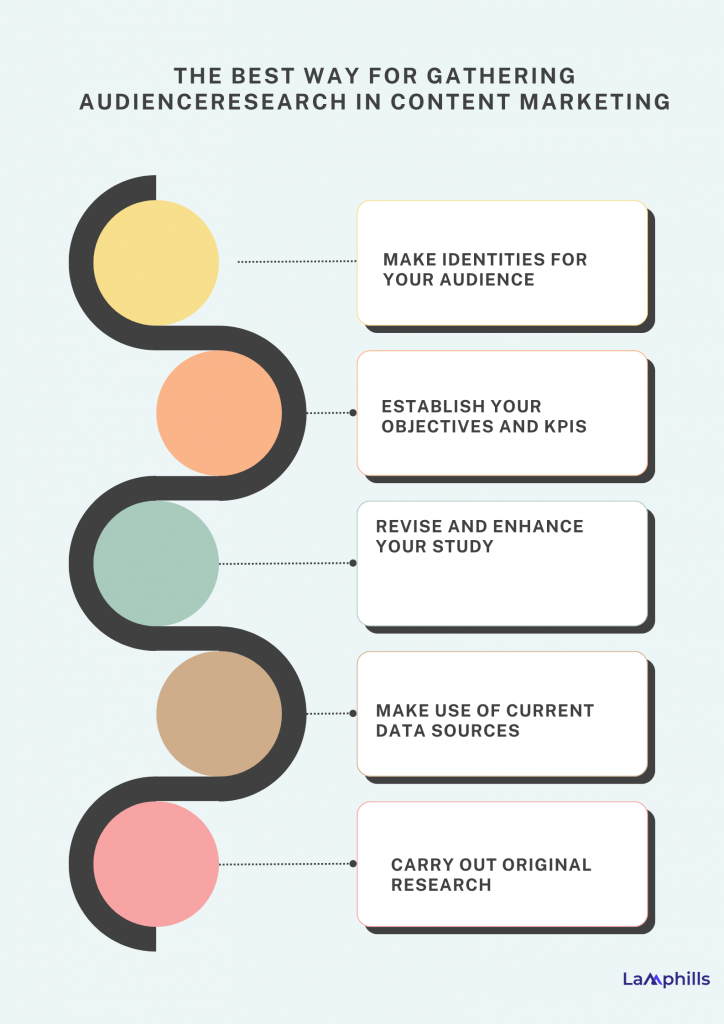Let me begin by saying that audience research is an essential component of marketing and advertising. Understanding the requirements and problems faced by the people who contact your brand will help you with messaging, search engine optimization, and—most importantly—client acquisition.
And this is what audience research helps you with at the fundamental level.
While I will go over the basics, my intention is to walk you through the process of conducting audience research in a way that benefits you, your target audience, and your business.
Key Takeaways
- Audience research aims to understand your target market’s wants, aspirations, and obstacles, allowing you to segment audiences and tailor marketing campaigns.
- There are two main types of audience research: quantitative (using facts, figures, and statistics) and qualitative (eliciting personal insights from customers).
- Creating audience personas based on research data helps adapt content to your audience’s specific interests, needs, and expectations.
- Using existing data sources (e.g., analytics tools, CRM systems, social media) alongside original research (surveys, interviews, focus groups) provides a comprehensive understanding of your audience.
- Effective audience research should be conducted with a specific organizational objective in mind and prioritize accessibility and inclusivity to avoid bias.
What is Audience Research?
Audience research is the process of trying to better understand your target market’s wants, aspirations, and obstacles. When conducting audience research, you must consider your target audience’s size, composition, and defining factors.
Your research will allow you to segment your audiences. These people share particular qualities, such as age, interests, or how frequently they use a product.
From there, you can make your marketing campaigns, content, and advertisements more relevant to your target demographic.
How to Research Your Target Audience
Audience research is an ongoing process that collects both quantitative and qualitative data.
#1. Quantitative Research
Quantitative research uses facts, figures, and statistics to overview your target audience groups.
This data comprises users’ demographics (age, location, education, and profession) and behaviour (online activity and purchasing patterns). It can be gathered via analytics solutions that track where consumers are located and how they interact with your marketing materials and products. Data capture forms are also helpful for collecting quantitative information.
#2. Qualitative Research
Conversely, qualitative research elicits personal insights from your customer base. It could contain reviews, feedback, exit interviews, survey findings, onboarding FAQs, and other information.
Other data sources include users’ psychographics (interests, attitudes, and lifestyle), which can be obtained through focus groups, surveys, questionnaires, and feedback forms. Survey generators, quizzes, and in-person meetups can all assist in collecting audience data.
Audience research solutions can also generate qualitative insights and keep audience research up-to-date, accurate, and processed according to your business requirements. These solutions save time and are more accurate than manual audience research.
The Best Way for Gathering Audience Research in Content Marketing

#1. Make Identities for Your Audience
After gathering and evaluating data from multiple sources, you may utilize it to develop audience personas—fictitious depictions of your ideal clients based on traits, requirements, and objectives. You can better adapt your content to your audience’s unique interests, needs, and expectations using audience personas. You may build and maintain your audience personas with the help of programs like PersonaApp, Xtensio, and HubSpot.
#2. Establish Your Objectives and KPIs
Before gathering data, you must clearly define your goals for content marketing and your metrics for success. Your buyer’s journey and overall business objectives should align with your goals and measurements. For instance, you may use metrics like website traffic, conversion rate, and email subscribers to produce more leads.
#3. Revise and Enhance Your Study
Audience research is crucial to content marketing to provide content that connects with your audience and motivates them to act. To stay up to date with your audience’s evolving demands and behaviors, you must continually update and improve your research—this is not a one-time task.
Also, to achieve this, you should keep an eye on the effectiveness of your content and the comments you receive, carry out fresh research as needed, divide up your audience into distinct categories, and experiment with different content formats, subjects, headlines, and calls to action. You can make sure that your audience research is useful in assisting you in reaching your content marketing objectives and expanding your company by adhering to these best practices.
#4. Make Use of Current Data Sources
You don’t have to start from scratch regarding audience research. Utilizing already-existing data sources, you can learn important details about your target audience’s characteristics, habits, tastes, and difficulties. For instance, you can see how users engage with your content, where they are coming from, and what they do on your website using analytics software like Google Analytics. You may learn more about your subscribers’ interests and how they reply to emails via your email marketing platform, like Mailchimp.
Furthermore, your social media accounts might reveal how fans interact with and share your material. Additionally, you can learn more about your clients’ identities and pain concerns by utilizing your customer relationship management (CRM) system. Finally, what consumers like and hate about your goods and services and their perceptions of your brand may be found in online reviews, testimonials, and feedback.
#5. Carry Out Original Research
You should conduct an actual research to obtain more detailed and qualitative insights into your target audience. This entails gathering information directly from your target population via user testing, focus groups, interviews, and surveys.
You can create and distribute surveys using tools like SurveyMonkey, Typeform, or Google Forms; schedule and conduct interviews using Zoom, Skype, or Calendly; recruit and moderate focus groups using FocusGroupIt, UserTesting, or UserZoom; and record and analyze user behaviour using Hotjar, Crazy Egg, or Optimizely. By conducting primary research, you can better understand your audience’s needs, tastes, opinions, motivations, difficulties, aspirations, and usage patterns of your material.
Meanwhile, our Content Relevance Checklist below is a priceless tool for honing your content strategy and optimizing its effects, regardless of your experience level in the field.
Content Relevance Checklist.pdf
The Best Practices for Audience Research
Effective audience research requires more than selecting the appropriate question and methodology. Ensuring your audience research process and guiding principles will foster genuine understanding and a solid rapport with your target audience constitutes the other half of the process. Before starting, take into account the following, as I always do:
#1. Research on Audiences Should Always be Conducted about a Particular Organizational Objective
The first stage is determining what you need to learn from audience research. Once you have a specific aim in mind, such as how often to publish a newsletter or what advantages your members want, write a brief study brief to assist you in focusing.
Acquiring actionable information will be challenging without a defined objective. Make sure you can envision yourself acting or altering your workflow, offerings, or coverage areas in response to data.
#2. Make Accessibility and Inclusivity Your Top Priorities
When “certain individuals or groups are excluded from the focus group for reasons not specified in the research plan,” bias in research recruiting occurs. For instance, hiring people just through online news sources excludes people who get their news offline, including the elderly or those without access to the internet.
The Local News Lab says, “English-only communications excluding non-English-speaking groups could be another recruitment bias.” Using random selection is crucial in preventing recruitment bias in audience research. Beyond DEI considerations, newsrooms that expand their reach beyond a select group of individuals with the means and capacity to readily engage will gain deeper insights.
#3. Remember that Audience Research Aims to Dispel Myths and Preconceived Notions about Your Members or Your Target Members
You must approach the process of conducting audience research with an open mind and be aware of the preconceptions and assumptions you have about your target audiences. Don’t be so rigid when the results are in that you can’t change how you see your audience and their demands. Put another way, avoid allowing any “lore” about your audience to influence how the results are interpreted. If you have any preconceived notions about your audience, putting them in writing to have a record to refer to later could be a good idea. You risk ruining your work before it’s even launched if you don’t let your audience research inform your decisions.
#4. When Deciding What Questions to Ask, Consider the Cultural Context
Throughout this book, MPP will provide ideas for questions to ask; however, you are the one who knows your audience the best. Asking inquiries that could offend someone or make them feel vulnerable undermines trust. It is important to discuss issues like gender and income level in a thoughtful, inclusive manner while keeping your cultural background in mind.
#5. Inform Participants in Audience Research about Your Intended Data Storage and Use
Before commencing, choose how you’ll handle tasks like data anonymization and public sharing of findings in collaboration with your team. Participants should be informed of this as clearly as possible, and any data you gather should be appropriately stored. Inappropriate use of data will erode participant trust.
#6. Don’t Forget to Give Synthesis Adequate Time
At the very least, devote the same amount of time and resources to data analysis as you did to method creation and response gathering. If you put in the necessary time to analyze your data, which includes discussing what you heard with one another, you will get better insights and conclusions that are both actionable and effective.
#7. Express Gratitude for Your Viewers’ Involvement
Express your gratitude to everyone participating in your audience research as soon as possible. Tag them as participants in your CRMs or other systems so that you can thank them for their work if you ever ask them again. Some researchers compensate volunteers with gift cards or cash. The study team advises providing participants with aggregated and/or anonymized results. This reaffirms that the community within your membership program shares knowledge and encourages one another.
#8. Make Conducting Audience Research an Ongoing Endeavor
After you’ve introduced your membership program or found a fresh method of engagement for your audience, your research doesn’t end. Additionally, you should look for ways to keep learning new things about your members’ values. Establishing and maintaining regular communication channels with prospective and existing members facilitates the identification of novel membership goods that benefit both parties.
Examples of Audience Research Approaches
#1. Audience Analysis Tools
Audience analysis solutions for large businesses automatically analyze and visualize data for audience segments. These technologies can also assist with competitive analysis and go beyond demographic data to reveal user habits and sentiments. They also help identify the ideal marketing platforms, influencers, and techniques for your brand’s customers.
#2. Customer Interviews
Speaking with clients over the phone or in person is one of the easiest but most effective ways to get to know your target audience. Conversations in real-time provide insight into clients’ lifestyles, motives, and purchasing challenges.
It also exposes purchasing triggers and can generate untapped marketing channels or resources for you to focus on. You may also include customers’ own words in your messaging to make it more meaningful to them.
#3. Competitive Evaluation
Competitive analysis entails monitoring your rivals’ advertising collateral and customer interactions. This includes their websites, email marketing, social media accounts, special offers, and customer feedback. Monitoring these areas can highlight areas where your competitors are falling short of audience expectations and expose opportunities for your brand to close.
#4. Questions and Surveys
Surveys and questionnaires allow you to ask specific questions of your audience and gauge how they feel about your brand, whether they are distributed via email, your website, or over the phone. With these resources, you can also collect additional audience data and provide incentives to customers who finish them.
What are the Standard Procedures for Carrying Out Audience Research?
After establishing your aim and determining the question you want to answer via audience research, there are several ways to go about the “how.”
#1. Expand on Prior Research
When attempting to use audience research to address a question, the first step should be to search for already published articles and studies on the topic. A good place to start is frequently the Reuters Institute for the Study of Journalism’s annual Digital News Report. The research team recommends desk research, comScore, or its equivalent for market and competition analysis.
#2. Examine Your Stats
You should then examine your stats. Metrics are generally the best way to get answers to queries about how people act, like how often they read your newsletter or when they open it. Your data may have all the information you require, depending on what you’re looking to learn about the people in your audience.
However, different research techniques will be needed if you have queries regarding audience members’ thoughts or feelings, for example. Patterns in your analytics may lead to inquiries about your audience’s behavior that need to be addressed through surveys or interviews. Which metrics to monitor? For additional information on creating a metrics approach that provides useful audience data, see “Developing membership metrics.”
#3. Make Use of Surveys
The most popular method for gathering data on your audience is through surveys, which are especially helpful when seeking quantitative data or targeted comments. A survey is a fantastic option if you want to quickly get a lot of replies to a certain question, and a large sample size is more important than nuance.
When you need to know your audience’s underlying needs, habits, or motivations, surveys are not a suitable choice. We suggest focus groups or interviews for this kind of data collection; for additional information on these techniques, go to the section below.
#4. Interview people
Interviews take a lot of time and effort, but they may provide a wealth of information when done effectively. Interviews work well for eliciting fresh ideas, gaining in-depth knowledge about attitudes or feedback, and comprehending motivation. When you need to be very deliberate about who you ask for feedback, interviews can be quite helpful. It is not a good idea to catalog behavior through interviews. Since people are famously terrible at reporting on their activity objectively, your metrics will paint a more accurate picture of the behavior of your audience.
You can use interviews alone or in tandem with surveys to do your audience research. After an audience research survey, you can provide interviews as an extra opt-in (for example, the final question could be, “Would you be willing to speak with a member of our team for 30 minutes on the phone?”). You should begin with a series of interviews to determine what to include in a survey you distribute to your audience.
#5. Conduct focus groups.
Focus groups are an excellent compromise when you require more detail than a survey can provide but lack the resources to conduct numerous one-on-one interviews. They are also an excellent way to gather a large amount of qualitative feedback swiftly and offer a unique chance to observe how individuals might challenge one another’s perspectives.
A focus group can be conducted with a small number of participants (five to ten persons representing the audience members who matter most for your topic or inquiry, which is our recommendation). If there are too few, the discussion may stall, and your team may need to step in. If there are too many, you won’t hear enough from any one person to get valuable insights.
Meanwhile, you can use the checklist below as a guide to help them go through the key steps involved in gathering qualitative data. Following these guidelines can help you improve the validity and dependability of your research, which will ultimately result in more insightful conclusions and well-informed choices.
This checklist will assist you in navigating the difficulties of qualitative research and maximizing the value of the data you gather, regardless of your level of experience in the subject.
Qualitative Data Collection Checklist.pdf
What is an example of audience research?
Audience research is a major component of corporate strategy and is applied extensively in many industries to strengthen brands. Here are a few instances: Lego—The firm decided to create products that would appeal more to females after conducting research and discovering that only 9% of its customers were female.
What are the two main types of audience research?
The two primary categories of audience research are qualitative and quantitative. A key component of qualitative research is obtaining detailed information on your audience’s demands, behaviors, and motivations. This research frequently uses activities and exercises, focus groups, in-depth interviews, and vox pops.
Conclusion
Conducting audience research has many benefits. It also ensures that relevant data is gathered, leading to improved business decisions.
Conducting audience research can help you learn more about what your customers want from you and how they want it delivered. This data can also be used to identify your target audience and determine the best way to reach them. It is a useful tool for market research because it makes it easier to understand what your target market wants so that you can create goods and services that offer value in exchange.
Related Articles
- 7 Unbelievable Audience Behavior Hacks That Will Skyrocket Your Conversions Overnight
- What Is Consumer Public Relations?: Key Strategies for Connecting with Your Audience
- 7 Brand Storytelling Techniques That Captivate Audiences
- How to Increase Brand Consideration Among Your Target Audience
- Food Journalist: Our 2024 Researched Picks (Updated)





